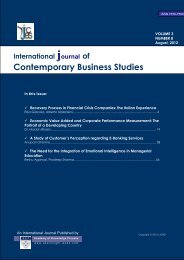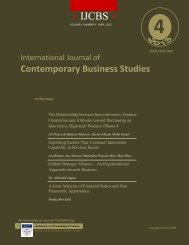International journal of Contemporary Business Studies
International journal of Contemporary Business Studies
International journal of Contemporary Business Studies
Create successful ePaper yourself
Turn your PDF publications into a flip-book with our unique Google optimized e-Paper software.
<strong>International</strong> Journal <strong>of</strong> <strong>Contemporary</strong> <strong>Business</strong> <strong>Studies</strong><br />
Vol: 3, No: 6. June, 2012 ISSN 2156-7506<br />
Available online at http://www.akpinsight.webs.com<br />
HYPOTHESIS<br />
1) H o = 60% investors are Rational.<br />
2) H o = 60% investors are Over Confident.<br />
3) H o = 60% investors are affected by Disposition Effect.<br />
4) H o = 60% investors are conservative.<br />
5) H o = 60% investors are affected by Cognitive Dissonance.<br />
6) H o = 60% investors are Regret Investors.<br />
The behavior can‟t be 100% same for all situations and for all human being. So for hypothesis testing,<br />
60% was taken as a benchmark for getting inventors‟ behavior. The alternative hypothesis for all H o was<br />
“less than 60%.”<br />
DATA AND METHODOLOGY<br />
Sampling unit<br />
For the survey respondent must be the person who invests in the Stock Market. Convenient sampling<br />
method is used for data collection. The questionnaires were filled out through personnel meeting with the<br />
investors. The respondents were survey outside the broking houses at respective cities.<br />
Sample Size<br />
The pilot study was conducted by surveying 20 investors. The human behaviour can not predict<br />
accurately. So, the confidence level was taken 93%. At 93% confidence, the sample size was derived at<br />
124. For reducing error and safer side the sample size was increased to 150. Total 150 questionnaires<br />
were distributed in Anand, Petlad and Khambhat (50 in each) out <strong>of</strong> which 130 generated valid responses.<br />
50, 46 and 34 questionnaire received from Anand, Petlad and Khambhat respectively. The sample was<br />
drawn as per convenience. The visitors and investors approached outside the brokerage house. The<br />
collected data were analyzed with the help <strong>of</strong> Minitab 16.<br />
Questionnaire Design<br />
The questionnaire (Annexure No. 1) was formed with 15 questions. Each question starts with a particular<br />
scenario or situation that may happen in the stock market. Then the respondents were <strong>of</strong>fered a set <strong>of</strong><br />
responses, which generally observed at a time <strong>of</strong> decision making. The questions were arranged in the<br />
following sequence to get proper understanding <strong>of</strong> investors‟ behavior and response.<br />
Question Number<br />
Behavioral Theory<br />
1, 10 and 11 Rationality<br />
2, 9 and 12 Over confidence<br />
3, 8 and 13 Disposition Effect<br />
4 and 14 Conservatism<br />
7 Cognitive Dissonance.<br />
5, 6 and 15 Regret Theory<br />
Copyright © 2012. Academy <strong>of</strong> Knowledge Process<br />
31
















